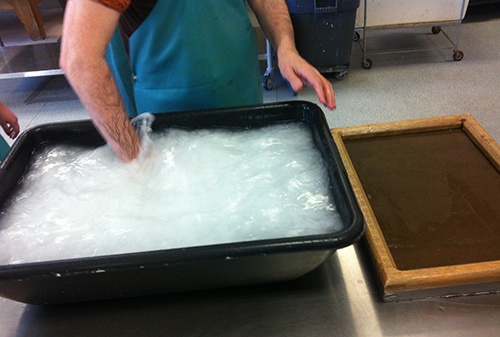
Newsflash: Digital Artist Makes Paper

Jeff Abell, our professor, showing us cotton rag pulp.
OK first thing is, I’m not really a digital artist per se. Indeed, I’ve used many different kinds of material —fabric, steel, plastic, etc. along with digital processes and media—but as of today, I have a new skill: papermaking.
Currently, we have two MFA programs, Interdisciplinary Arts & Media, and Interdisciplinary Book & Paper (B&P). I’ve always been pretty far over on the arts and media side, which is primarily based in modern technology, particularly digital image and sound software and electronics. And I’ve been happily taking classes in that curriculum for the last two-and-a-half years, and creating 3D work that had digital elements.
However, I’ve always wanted to check out the book, paper and print studios. I see the work of my colleagues all the time, and I’ve always been intrigued. I’ve also seen a lot of the B&P students in classes that work primarily with digital arts, and been impressed by the collaborations I’ve seen, as well as the really interesting art that’s come out of it. Finally last fall I took a bookbinding class and loved it. There was something so meditative about it, and so…. old school.

Jeff mixes the pulp into a vat of water.
If bookbinding seems old school, papermaking is ancient school. You can almost see our ancestors doing the exact same thing we just did in class—mush some wet plant material together on a flat surface so it dries as something you can write on. (Er… please don’t repeat that explanation to my current professor. Though in my opinion, it’s not too bad of a summary.)

Jeff pulls out a sheet of paper, which is resting on top of a mold and topped by the wood frame (deckle).
The other thing about papermaking is it’s EXHAUSTING. By the end of our four-hour class, my back and feet were SORE, and I took the elevator down a flight of stairs to get out of the building. The whole process involves constantly breaking the surface tension of the water by lifting paper molds (the screens) and deckles (the frames on top of the molds) out of a vat of paper pulp. Do that for a few hours and your back feels it—believe me.

Wetting the felt before we put the pellons and paper on it. Pellon and felt are what you put between the sheets of paper you make so you can squeeze the water out without the paper sticking.
The other thing about papermaking is it’s WET. The pulp is wet. The pellon and felt are wet. The floor is wet. The counters are wet. I’m just not used it, though it’s fun. We all wear high rubber boots and long waterproof aprons and it feels like we are all in a secret society of busy, water-obsessed artists. Everyone is very focused and water is constantly sloshing and dripping in the background. It takes a long time to clean up, definitely longer than shutting off a computer after editing a video.

Laying out the felt—once everyone is finished, the cart is rolled over to the press behind it, and all the water is squeezed out.
If I look back over the last few years of grad school, it’s really been interesting to see skills develop in areas I really didn’t expect. That’s been a huge plus of being in this very interdisciplinary MFA program. So, now that I know what’s involved in papermaking, I can start dreaming up a new project!
